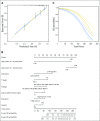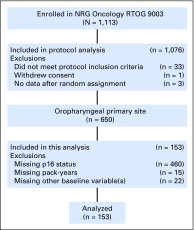Development and Validation of Nomograms Predictive of Overall and Progression-Free Survival in Patients With Oropharyngeal Cancer
- PMID: 28777690
- PMCID: PMC5736236
- DOI: 10.1200/JCO.2016.72.0748
Development and Validation of Nomograms Predictive of Overall and Progression-Free Survival in Patients With Oropharyngeal Cancer
Abstract
Purpose Treatment of oropharyngeal squamous cell carcinoma (OPSCC) is evolving toward risk-based modification of therapeutic intensity, which requires patient-specific estimates of overall survival (OS) and progression-free survival (PFS). Methods To develop and validate nomograms for OS and PFS, we used a derivation cohort of 493 patients with OPSCC with known p16 tumor status (surrogate of human papillomavirus) and cigarette smoking history (pack-years) randomly assigned to clinical trials using platinum-based chemoradiotherapy (NRG Oncology Radiation Therapy Oncology Group [RTOG] 0129 and 0522). Nomograms were created from Cox models and internally validated by use of bootstrap and cross-validation. Model discrimination was measured by calibration plots and the concordance index. Nomograms were externally validated in a cohort of 153 patients with OPSCC randomly assigned to a third trial, NRG Oncology RTOG 9003. Results Both models included age, Zubrod performance status, pack-years, education, p16 status, and T and N stage; the OS model also included anemia and age × pack-years interaction; and the PFS model also included marital status, weight loss, and p16 × Zubrod interaction. Predictions correlated well with observed 2-year and 5-year outcomes. The uncorrected concordance index was 0.76 (95% CI, 0.72 to 0.80) for OS and 0.70 (95% CI, 0.66 to 0.74) for PFS, and bias-corrected indices were similar. In the validation set, OS and PFS models were well calibrated, and OS and PFS were significantly different across tertiles of nomogram scores (log-rank P = .003;< .001). Conclusion The validated nomograms provided useful prediction of OS and PFS for patients with OPSCC treated with primary radiation-based therapy.
Figures





References
-
- Fakhry C, Westra WH, Li S, et al. : Improved survival of patients with human papillomavirus-positive head and neck squamous cell carcinoma in a prospective clinical trial. J Natl Cancer Inst 100:261-269, 2008 - PubMed
-
- O’Sullivan B, Huang SH, Siu LL, et al. : Deintensification candidate subgroups in human papillomavirus-related oropharyngeal cancer according to minimal risk of distant metastasis. J Clin Oncol 31:543-550, 2013 - PubMed
MeSH terms
Substances
Grants and funding
LinkOut - more resources
Full Text Sources
Other Literature Sources
Medical

